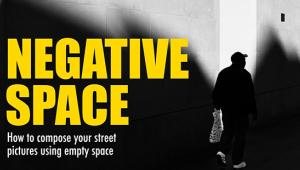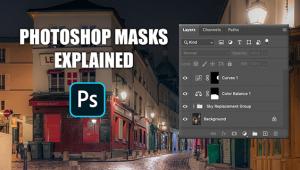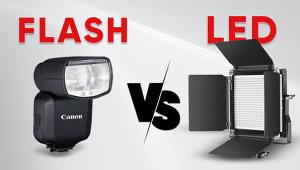Holiday Books For The Digital Photographer
"Be careful about reading health books. You may die of a misprint."
--Mark Twain
Even with the massive sale of US book publishers to foreign companies and the
payment of million dollar advances to authors whose books don't sell,
2006 produced more and better digital imaging books since I started this annual
feature. This current generation of books is better designed and more comprehensive
than previous offerings. Here are my picks of some of the best digital imaging
books of the year:
Photoshop Elements: Drop Dead Photography Techniques; edited
by Steve Luck; Lark Books; 224 pages; $29.95; softbound; (ISBN 1-5799-0669-9)
The song "Nobody Does It Better" is from a James Bond movie but
could have been written about Lark Books. Photoshop Elements: Drop Dead Photography
Techniques is just one example of this publisher's commitment to excellence.
While Photoshop often gets the spotlight, the less-expensive Elements is a useful
digital imaging tool and this books shows why. Easy-to-follow tutorials feature
large, colorful screenshots and images that are spread across just a few pages,
making them easy for the short-attention span generation to digest. The book
begins with the briefest introduction to digital imaging, then takes you through
basic methods that anybody can use to improve their photographs, before moving
on to more advanced techniques. You'll be an Elements expert in no time!
 |
Master Composition Guide for Digital Photographers; by Ernst
Wildi; Amherst Media; 130 pages; $34.95; softbound; (ISBN 1-58428-179-0)
This beautifully designed book represents this master photographer's magnum
opus on the subject of composition. It is filled with before and after examples
that demonstrate the difference between so-so composition and a well-composed
photograph. The subject matter is precisely dissected and arranged into 19 chapters
that address everything from compositional elements to understanding the importance
of color. The book shows how the right filter and lens choices can improve composition,
and shows how to pose and place a subject within the image frame for maximum
impact. Lastly, there are tips on post-capture manipulation to improve composition.
This last one is oh-so-brief, so perhaps Mr. Wildi will grace us with a new
book on this particular subject.
 |
National Geographic Photography Field Guide: Digital Black &
White; by Richard Olsenius; National Geographic Society; 160 pages; $24.95;
softbound; (ISBN 0-7922-4196-7)
Naysayers who said digital imaging would mean the death of black and white photography
should pick up a copy of this book to see how digital imaging has ensured that
monochrome images are as much a part of this millennium as the last two. The
book is small enough to fit inside your camera bag as a reference or read on
an airplane when you're wondering how to add pizzazz to the next shoot.
While half of the book is aimed at film shooters, the second half shows how
to process black and white images within a digital workflow. Most of the images
belong to Richard Olsenius, but he wisely brings in photographers with different
visual styles and points of view to add to the usability of this slender volume.
By showing the power of monochrome imagery Olsenius demonstrates why at least
a few of your next photographs should be in black and white.
 |
George DeWolfe's Digital Photography Fine Print Workshop;
by George DeWolfe; The McGraw-Hill Companies; 272 pages; $39.99; softbound;
(ISBN 0-0722-6087-4)
The amusing fact that the book's cover designer placed the tag "full
color" on top of a black and white photograph only proves you can't
tell a book by its cover. George DeWolfe has put together a step-by-step guide
for producing fine art digital prints, starting with evaluating its qualities.
DeWolfe sets it up and then tells you how to achieve this goal between the covers
of this modest volume. There are no quick fixes or tweaks; DeWolfe shows you
the tools and how to use them to create luminescent results with the admonition
that creating digital fine art takes "skill, experience, and time and
vision." Yes kiddies, there is no digital free lunch. This book is for
those who remember Fred Picker's Zone VI Workshop and have been looking
for the digital equivalent.
Back To Basics
How Digital Photography Works; by Ron White; Que; 180 pages; $29.99;
softbound; (ISBN 0-7897-3309-9)
The phenomenally detailed illustrations by Tim Downs alone make this book worth
the cover price; it's also an indispensable guide for anybody who wants
to learn the nuts and bolts of digital photography from optics to the best explanation
of noise you will read anywhere! The book includes an exploration of the differences
between image sensor types that is covered in two full pages, followed by an
investigation of the Foveon sensor. That's followed by another beautifully
illustrated spread on how an image becomes data. There's even a section
on inkjet and dye sublimation printers! This may sound like dry stuff, but Ron
White's tightly written prose and Downs' illustrations make it fun.
If you want to learn how digital photography works, get this book.
 |
Digital Photography in Available Light: Essential Skills;
by Mark Galer; Focal Press; 248 pages; $29.95; softbound; (ISBN 0-240-52013-0)
While this may be an entry-level book, it is maybe the best one currently available
on digital photography with available light. Newbies will love the introductory
section on camera and asset management, but the meat of the book begins with
the chapter on "Exposure" that not only makes the technical details
understandable but provides example photographs showing the aesthetic issues
as well. On a personal note, I liked the book's design so much I asked
for the same graphic artist for Getting Started with Digital Imaging (see "Shameless
Commerce Division" sidebar below).
Spring Into Digital Photography; by Joseph T. Jaynes and
Rip Noël; Addison-Wesley; 312 pages; $34.99; softbound; (ISBN 0-1318-5353-8)
This book is a bit text heavy and features a pedestrian design but represents
a crash course in digital photography that's ostensibly aimed at professionals
but seems ideal for aspiring professionals. It features a mélange of
topics from monitor profiling to fixing redeye--all of the good stuff you
need to learn if you're serious about digital photography. The heart of
the book is found in the first three chapters: "Let There Be Light,"
"Compose It," and "Expose It." What follows is the kind
of technical information you'll need to transfer these images from your
mind, through the camera, and into the world.
 |
40 Digital SLR Techniques; by Darrell Tan and Eu Lee; Wiley;
160 pages; $16.99; softbound; (ISBN 981-053520-1)
This little book makes a great holiday gift for the beginning digital SLR photographer.
Beautifully printed in Korea but a little under-illustrated, at least based
on the title and cover shot, the book reminds me more of a generic Magic Lantern
Guide that includes techniques that fall into the category of basic camera operation.
If this is new stuff to you, the information will be invaluable. It's
a fun, quick read and a useful reference book.
 |
Digital Nature Photography and Adobe Photoshop; by Kevin
Moss; Thomson; 330 pages; $39.99; softbound; (ISBN 1-9863-135-7)
Kudos all around on this book. A lot of credit goes to Thomson for producing
one with a "landscape" orientation. They wrapped the book in a wonderful
design with supporting text and illustrations by Kevin Moss. The first half
reads like a master class on nature photography. The second half is all about
what to do with the photographs when you get them into your computer. Moss starts
with using Adobe Bridge to manage images and then shows how to make tonal and
color corrections. His before and after illustrations show how judicious and
realistic application of these digital tools can make your nature photographs
sing.
How to Use Flickr: The Digital Photography Revolution; by
Richard Giles; Thomson; 276 pages; $24.99; softbound; (ISBN 1-59863-137-3)
If you don't know about Flickr, you should. Flickr is an online photo
management and sharing application that has two goals: To make your photos available
to those people who matter and provide new ways of organizing photos. Flickr
makes it possible to keep a photo blog or securely and privately share photos
of your kids with family across the country. Part of the solution is making
the process of organizing photos collaborative. With Flickr, you can give your
friends, family, and other contacts permission to organize your photos--not
just add comments but also notes and tags. With a competent design and monochrome
reproduction, the book remains the perfect introduction and user's guide
to using this online service.
Technique
Professional Digital Techniques for Nude & Glamour Photography;
by Bill Lemon; Amherst Media; 128 pages; $34.95; softbound; (ISBN 1-58428-178-2)
This is the best book on nude and glamour that's been published in a long,
long time. While most publishers are content to simply recycle nude photography
books written by British authors, only Amherst Media has the courage to publish
one by an American writer/photographer. The images found in similar UK-based
books seem locked into a 1970s sensibility, but Bill Lemon's nude and
glamour photography is fresh and contemporary and oh-so-this-millennium. The
book is beautifully printed and designed and filled with text that illuminates
the subject. It is enhanced by spectacular images from this master of this genre.
Lemon shows you literally how "to see the light" to create soft
monochrome images or photographs with eye-popping color.
 |
Digital Nature Photography Closeup; by Jon Cox; Amphoto Books;
160 pages; $24.95; softbound; (ISBN 0-8174-3674-X)
This book is a delightful pastiche of the technical and aesthetic considerations
involved in macro photography and is illustrated with some of the best close-up
photography I've seen. It's more than just a gussied-up book on
macro photography that tosses a few "digital" terms around. The
author includes a serious chapter on working with histograms and raw files.
The chapter called "The Digital Darkroom" includes a good introduction
to digital workflow and color management but also manages to address the question
of "honesty" when working in the field of digital nature photography.
It encourages photographers who try to fool Mother Nature to 'fess up
with appropriate captions. The bug factor that's typically high in these
kinds of books is limited and those "creepy crawlies" that appear
are fun.
 |
Digital SLR Pro Secrets; by David D. Busch; Thomson; 316
pages; $39.95; softbound; (ISBN 1-59863-019-9)
While I wish it had more photographs, this book provides the kind of "secrets"
that can make the difference between capturing a good shot or a great one. Chapters
are technique driven with the opener covering how to improve your image quality,
a topic often overlooked in many photo books who seem to have more of a "we'll
fix it later in Photoshop" attitude. David D. Busch helps you capture
it on the chip the first time, making this one chapter a valuable reference.
He's included a good chapter on infrared photography with the highlights
being the section on post-processing, showing how to produce clever color IR
effects. Many photographers like to build gadgets and gizmos; chapter seven
delivers and includes one of my favorite old ricks--making and using a
Harris Shutter. If you're not familiar with this technique, you'll
love this chapter.
 |
Digital Sports Photography: Take Winning Shots Every Time; by
Serge Timacheff and David Karlins; Wiley; 359 pages; 29.95; softbound; (ISBN
0-7645-9607-1)
While hampered by a lackluster design and a dearth of photographs, Serge Timacheff
and David Karlins' text makes this a worthwhile addition to your bookshelf.
The authors include tips from more than 20 sports photographers, including Terrell
Lloyd, who is the official photographer of the San Francisco 49ers. While fencing
is covered (Timacheff is the official photographer for the International Fencing
Federation), motorsports is ignored in favor of "stick and ball"
sports. This is not the authors' fault as much as Wiley's, who like
most photo book publishers choose to ignore the most popular sport in the world.
If you're interested in sports photography as a vocation or avocation
this is a good place to start.
 |
- Log in or register to post comments

















































